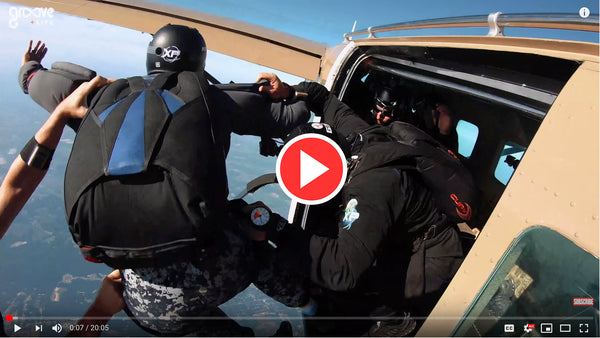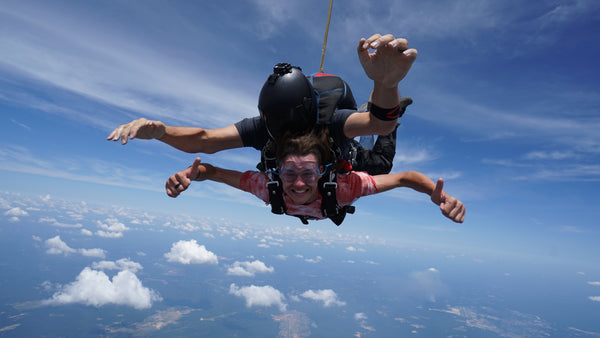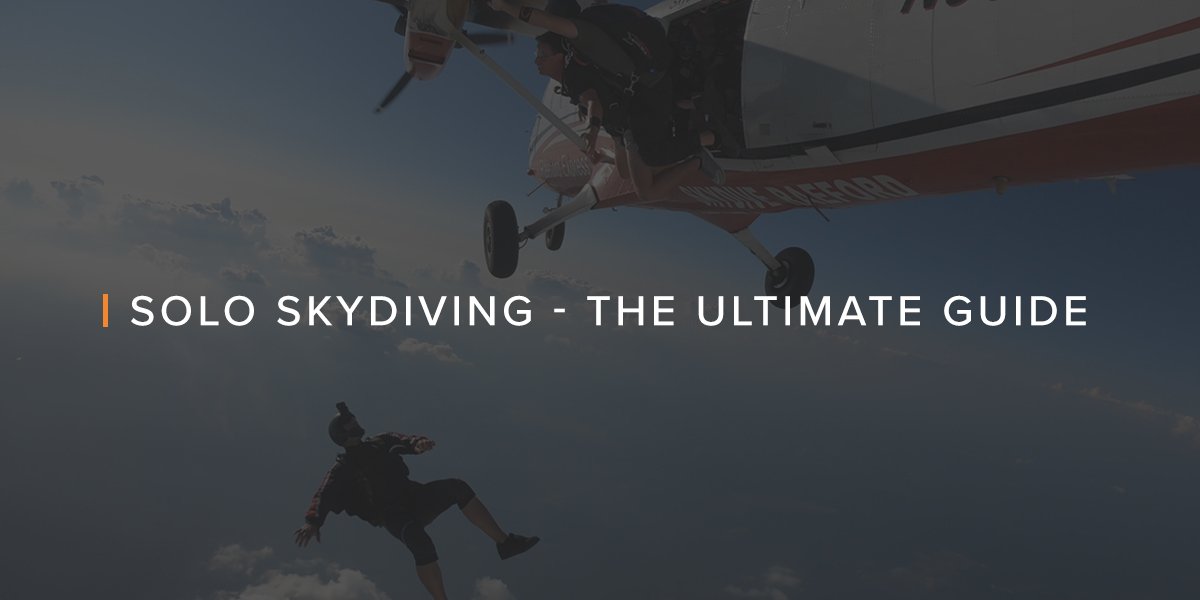
Skydiving Solo | The Ultimate Guide
Learn How to Go Skydiving... Solo.
Man has accomplished a lot of crazy things since the beginning, from climbing the tallest mountain on earth to swimming way deep in the ocean! By far, one of the craziest things of all is this - man has leapt out of a plane thousands of feet above the ground and lived to talk about it.
We call this adventure skydiving… and if it’s crazy enough for mankind, it’s just the right adventure for Groove Life!
Click here to view the adventure on Amazon Prime Instant Video.
The Ultimate Guide to Skydiving Solo
- History of Skydiving
- What is Skydiving?
- Outline of Skydiving Gear
- How Dangerous is Skydiving?
- Who Can Go Skydiving?
- What are the Options for Skydiving?
- What Do I Need to Go Skydiving?
- Do I Need Professional Training?
- Is Certification Required to Go Skydiving?
- Skydiving Training Schools and Where to Find Them
- Comparison of Skydiving Equipment Suppliers
- Conclusion
- Appendix
Skydiving is one of those things that somehow makes it onto every bucket list. Super Cool Dude: Yeah… I’d like to run a marathon, get married, make a million dollars… and SKYDIVE! (insert collective gasp)
While the world dreams of skydiving, putting it as a crowd pleaser at the top of their collective bucket list, few of them actually get up the guts to “s’wing it!” In fact, only an estimated 350,000 people skydive each year. That’s less than the entire population of Cleveland, Ohio… just ONE city in the United States! Compare that with the world population of 7.53 BILLION and you can see how small of a percentage of people actually fulfill their dreams of flying!
A crazy adventure that everyone dreams of doing + a small percentage of people that actually do it = an opportunity that the Groove Adventure Team will NEVER pass up!
We decided that not only were we going to skydive, but we were going to go SOLO! It was the adventure of a lifetime and, in this guide, we’re going to give you the inside scoop on how we did it!
First, let’s start out with the story of skydiving. How did it all begin?
If you'd like to check out the entire skydiving episode from our Project Adventure show on Amazon Prime Instant Video, click here!
History of Skydiving
Hundreds of years ago, way before the Wright Brothers took to the skies in a tiny plane, the Chinese base jumped from cliffs. Even in the 1100’s, people were looking for ways to soar.
Although base jumping in the 1100s was the first recorded instance of the idea of “parachuting” that we know of, Leonardo DaVinci also did some experimenting with the thought of flying. While he never attempted to jump with his inventions, he drew up plans for a triangle-shaped device that could slow a man’s fall to earth. This device was not tested at the time but probably would not have been a successful flight if it had. It wasn’t until Andre-Jacques Garnerin created a canvas canopy, attached it to a basket, and jumped out of a hydrogen balloon with it in 1797 that skydiving officially began.
Skydiving became a national sport in 1952 but tandem skydiving wasn’t an official sport until the 1980’s! Since then, it has grown in safety and popularity! Now, skydiving is accessible for just about anyone who wants to give it a try!
What is Skydiving?
Before we move forward, it is important for you to know what we’re referring to when we talk about “skydiving.”
Skydiving, also known as parachuting, is an extreme, competitive sport! Skydiving is generally known as a method of going from a high point to the Earth, using the force of gravity to help and slowing the fall with a parachute, and involving some length of time free-falling.
While skydiving is most commonly associated with “tandem” skydiving, which is when an instructor or experienced, certified skydiver takes another person along for the experience, it can have many different purposes!
On our adventure, the Groove Adventure Team got to watch the Olympic skydiving team practice inside the Paraclete wind tunnel. They completed a series of intricate, in-sync formations that test the skill, strength, and coordination of each person!
Perhaps the most impactful use of skydiving, however, is in the military! In fact, skydiving has become a very useful tool to complete missions. Military skydiving styles include Army Airborne static line jumping, which is a low jump with a round parachute, and HALO/HAHO jumps, which are high altitude and usually completed by Special Operation Forces.
Our adventure team got to fly with the very best - the US Army “Golden Knights,” who have completed thousands of jumps and take safety and efficiency very seriously. They were incredibly skilled and made the whole experience fantastic and memorable! Our lead coach, Greg Windmiller, has six world championships and five world records under his belt. Greg owns and operates Superior Flight Solutions in Raeford, North Carolina.
Outline of Skydiving Gear
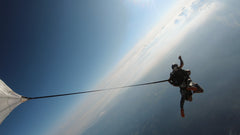 Before you go leaping out of a plane into a freefall from the sky, you should know what kind of gear you will be trusting with your life!
Before you go leaping out of a plane into a freefall from the sky, you should know what kind of gear you will be trusting with your life!
Over the years, skydiving has become so popular that safety and efficiency is a top priority. We like to say that your jump is only as good as your gear! If you have top-of-the-line gear, your skydiving experience will be enjoyable and thrilling! If, however, your gear is not adjusted correctly or if you are missing an essential component, things can go awry really fast!
Always make sure you triple check and your skydive buddy double checks all of your gear before you head for the skies.
Container and Harness System
This is what many refer to as the “pack” of the parachute. Your canopy, reserve, and AAD are meticulously packed in an exact way to fit into a container which is securely fastened to a harness. That harness is then securely fastened to you as if your life depends on it… because it does!
Main Canopy
Your main canopy is the parachute you will use to slowly descend to earth after the free fall. It is very carefully packed into the container so when it is released, it will unfold just right, without tangling.
Reserve Canopy
Your reserve canopy is a very necessary precaution. While you hopefully will never have to use your reserve, it exists to keep you safe if something were to happen to your main canopy. Never skydive without a professionally packed reserve chute.
Automated Activation Device (AAD)
This little device has literally saved so many lives. It is, in essence, a small computer that tracks your altitude and descent rate based on barometric pressure. If you are descending too fast at a certain altitude, it automatically deploys your reserve chute! Talk about a lifesaver!
Jumpsuit/Helmet
When our team completed the tandem jumps, we didn’t wear jumpsuits… we left that to the instructors! We quickly learned that the jumpsuits are for protection… and WARMTH! When you’re soaring up among the clouds, the air gets cold fast! It was shocking to feel that chilly air - you’d better believe we bundled up for the second jump! Our instructors told us that the temperature drops by one degree every 5.4 degrees every 1,000 feet.
When you’re experiencing a sport as extreme as skydiving, you have to be ready for anything - from accidentally landing in an unanticipated location and coming in contact with trees, or coming in too fast and meeting the ground faster than intended. That is why you should wear a protective layer AND a helmet. It’s better to wear a little extra protection to stay safe!
Altimeter
This handy, little watch-like device is one of the most important parts of your gear. As you’re dropping through the air, it can be easy to get caught up in the experience and it’s hard to know how much time you have. Earth catches up to you much faster than you would think! With just a glance at your altimeter, you can check your altitude and see how much time you have before you need to pull your chute.
How Dangerous is Skydiving?
You leaping out of a plane that is flying thousands of feet above the earth… umm…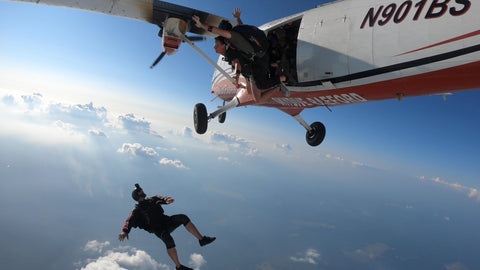 YES it’s dangerous. While skydivers take every precaution possible to ensure that it is safe, you always run the risk that if something goes wrong, you have very little time and few options to correct it. That being said… skydiving technology is far more advanced than ever before, and the average fatality rate is lower than ever
YES it’s dangerous. While skydivers take every precaution possible to ensure that it is safe, you always run the risk that if something goes wrong, you have very little time and few options to correct it. That being said… skydiving technology is far more advanced than ever before, and the average fatality rate is lower than ever
Skydiving is one of the safest extreme sports you could experience.
If you’re considering skydiving… just make sure you count the cost. Something could go wrong, and you could lose your life. That being said… there are a lot of things you could do that are more likely to cause injury than skydiving… including hopping in a car! Also, keep in mind that, according to the USPA (United States Parachute Association) there were 13 fatal skydiving accidents in the U.S. in 2018, out of roughy 3.3 MILLION jumps.
So, how can you go skydiving safely, with minimal chance of injury?
Go with the experts.
#1 tip right here. You need to double and triple check on the skydiving place you plan to use for your adventure. Make sure they are certified by the USPA, read reviews online, and ask to see the license of your instructor! You want to make sure that your safety is their #1 priority.
Make sure you invest in the best training.
If you’re planning on becoming certified to jump on your own, make sure you invest in the best training possible. Our Groove team went skydiving at Skydive Paraclete in Raeford, North Carolina, and it was a fantastic experience! All of the instructors were meticulous in safety checks, and kept the team spirits upbeat and alert. They were so detailed in their training that our adventure team members were all able to feel confident and safe at the end of the course.
Stay focused.
Skydiving is a heart-thumping, adrenaline-pumping THRILL, and that can definitely be distracting in the moment. You have to make sure that you are 100% focused at all times and check your gear, your chute, and your altitude before you take a second to look around.
Check the weather.
Skydiving, as you can imagine, is very weather-sensitive because it involves a parachute. Parachutes can easily get tangled if things get crazy, so make sure you double-check the weather conditions before you decide to take the leap. This is another reason why it’s important to get proper training… your instructors will make sure you know when it is safe to jump.
Some things to keep in mind: any sort of cloud or fog will make it nearly impossible to skydive. You don’t want to have anything obstructing your sight as you direct your parachute to a clear landing zone. Also, wind is a HUGE player in skydiving safety. Wind can either change the course of your parachute when it is in the air, or it can even reinflate it after you have landed. It’s always better to stay on the ground if it is a breezy day. Finally, rain can be very problematic for skydivers. Not only does it come from clouds - remember… sight obstruction - but it also is incredibly painful!
Don’t skip meals.
While technology like the AAd is advanced enough to cover human error like distraction, or complications like a seizure, you never want technology to replace your own use of common sense! Make sure you eat - preferably a healthy, whole meal that fuels your body without overdoing it on sugars or unhealthy choices. You don’t want to feel sick, weak, or dizzy from either lack of food or bad food choices because your mental awareness is imperative while skydiving.
Keep your equipment up to date.
After you are a certified skydiver with your own equipment, it can be easy to relax and trust your gear. While this is good, it is very important that you complete routine gear checks. According to the USPA, “The Federal Aviation Administration (FAA) requires that the reserve parachute be inspected and repacked every 180 days (whether it's used or not) by an FAA-certified parachute rigger.”
In summary, never cut corners on safety. Stick to the rule… when in doubt, don’t go. Stay safe, and keep having fun!
Who can go Skydiving?
While lots of people dream of skydiving… it’s not for the faint of heart! And… it may not be for a lot of other people, too.
Now that you know what skydiving is and what gear is needed, it’s time to talk about who can go!
You can go skydiving if…
You understand the risk, and make an educated decision.
Any extreme sport includes a large amount of risk. When you sign up to learn how to skydive, you are choosing to subject yourself to the possibility that you could experience something between a minor injury to a fatal accident. If that is something you are willing to risk… move on to item #2!
You are strong enough to keep the necessary form.
Skydiving is not a simple dive into the great unknown! If you’re interested in learning to go skydiving on your own, the sport requires a specific form and some core strength to keep from tumbling into a spin. You’ll need to assess your physical strength and agility to ensure that you are capable of holding that form for an extended period of time.
You are over 18.
By United States law, you must be 18 years old to skydive. Yep… that’s about it on that one!
You are awesome.
Skydiving takes a little strength, a little determination, and a whole lot of awesome! We’re going to take a wild guess and say… if you’re reading this right now, you already are pretty dang awesome!
Now that you know WHO can go skydiving… it’s time to get into the options.
What are the options for Skydiving?
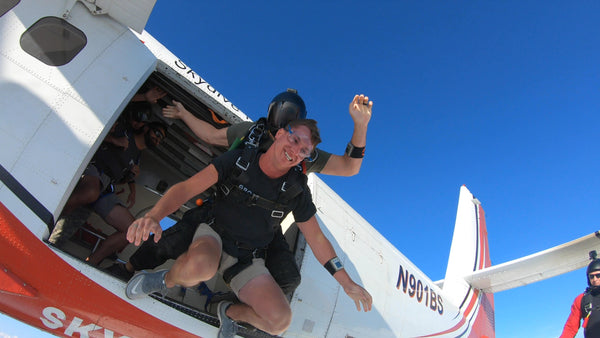
If you’re thinking about going skydiving for the first time, you’re probably curious what that is going to look like, and what your options are!
Tandem freefall
First, before you decide to become certified to skydive solo, you’ll probably want to try a tandem dive and make sure it’s enjoyable! You can probably find a tandem skydiving option near you, but make sure they are certified before you go!
Indoor wind tunnel skydiving
Many large cities have an indoor skydiving zone! The Groove Adventure Team was able to learn and practice accurate skydiving form inside with an indoor wind tunnel belonging to Paraclete XP Indoor Skydiving, which was so helpful and a much safer training option than learning the hard way thousands of meters above the ground!
In fact, some people exclusively participate in indoor skydiving, leaving the freefalling to the rest of the world!
Earn a skydiving certification
The Groove team took on this ultimate challenge to work toward obtaining a skydiving certification and training to dive solo! This is a good fit for those who would like to take on skydiving as a regular hobby! We highly recommend this option to you if you are an adrenaline junkie and like to live life on the edge!
What do I need to go Skydiving?
When you’re planning to go skydiving for the first time… you’ll need to do a little preparation! If you want to have success on the first try, make sure you have access to these essentials when you show up for your first flight!
A whole lot of courage
It takes more than a little courage to leap from a plane! You’ll need to pack an extra dose of courage for this adventure, because, if you’re like most people, your instinct will want you to stay inside where it is safe!
Comfortable, appropriate clothing
Skydiving isn’t the most forgiving sport because it involves wind, a harness, and a potentially bumpy landing! You’ll want to wear clothes that are long enough on your legs and shoulders that the harness will not be touching skin. Also, try to avoid clothing that is overly loose or has loose parts, like a collared shirt, that could obstruct your vision or annoy and distract you on the way down. Finally - we recommend that you leave your jewelry including wedding bands at home, (unless it’s a silicone Groove Ring of course ;) so nothing could get caught or fall off on the descent.
Gear - rented or owned
If you are training, you’ll likely have equipment provided to you. Once the training is complete, however, you’ll need to either rent your gear or purchase your own. We will go into more detail on gear in a later section.
A super talented instructor
You’ve heard us say it before, and it’s still true! Your skydiving instructor is the most important part of your experience! Whether you are tandem diving with an expert or training to fly solo, make sure you’re investing in someone who really takes it seriously!
And that leads us to our next section...
Do I Need Professional Training?
If you’re hoping to experience a lifetime of skydiving, you ABSOLUTELY need quality training. In fact, we have found that proper training is as important as the quality of the equipment you trust to get you to the ground safely. If you are well trained, you will know how to get yourself out of sticky situations, when it is safe to fly, and how to maneuver your parachute with the best. During our training at Paraclete in North Carolina, we felt completely safe and trusted our instructors entirely. When the time came to complete the accelerated freefall, we knew we were ready to face whatever might happen.
What to look for in a skydiving instructor:
Certified
If your instructor isn’t certified… you should be very concerned. Make sure your instructor is certified with USPA.
Experienced
You shouldn’t be trusting your life with a brand new skydiver. Make sure your instructor has a good amount of jumps under his or her belt before you decide to train with them.
Trustworthy
You’re just going to have to trust your gut with this one! Chances are, if they are certified and experienced, your instructor will be trustworthy. That being said, if you feel unsafe in any way in their presence - if they are careless or do not check your gear and notice the small things - don’t hesitate to ask for a different instructor. It’s always best to be safe.
Great personality
This is a must-have to make your experience amazing! Our instructors at Paraclete were energized and upbeat! We had a great time and felt super relaxed during the whole process, thanks to the amazing sense of humor and laid back personality of each instructor!
Takes safety seriously
When you’re deciding where to invest in skydiving lessons, ask the right questions. “What are some things you do to guarantee safety?” “Do you use AAD technology?” “What does the training process look like?” Their answers to these questions will clue you in to how seriously they take your safety. You can also check online reviews to make sure this is the right instructor for you.
Pays attention to details
We mentioned this earlier, but if you instructor doesn’t seem to be interested in double checking gear and teaching the smaller details, you probably should look for an instructor elsewhere.
Is a Certification Required to go Skydiving?
You do not need a certification to go tandem skydiving, but you definitely do need a skydiving license if you are planning on completing solo dives in the future.
It’s actually surprisingly easy to obtain your skydiving license… it just requires an investment of time and money, but the more jumps you complete, the cheaper it gets! If you are an experienced skydiver with your own equipment and a valid license, it is very inexpensive to hop on a flight with a local skydiving location.
Skydiving license: the deets.
The official USPA website outlines the different skydiving licenses and how to obtain them on their website. Here’s the scoop, straight from the USPA SIM (Skydivers Instruction Manual):
Skydiving A License
This license is the first license you’ll receive as a skydiver… and it’s probably the most expensive! With this license, skydivers are able to jump without an instructor, pack their own main chute, jump into water, and complete basic group jumps.
According to USPA, the requirements for this license are:
- completed 25 freefall jumps
- completed all requirements listed on the USPA A License Proficiency Card
- completed five group freefall skydives involving at least two participants
- received the signature and official stamp on the USPA A License Proficiency Card or USPA A License Progression Card (ISP) which validates the A license for a 60-day time limit following the completion of the card
- The completed and signed USPA A License Proficiency Card or USPA A License Progression Card must be validated within 60-days of completion by sending the card to USPA Headquarters. Once validated, USPA will issue a license number that becomes a permanent record of the member.
- passed the USPA-developed written and oral USPA A-license exams conducted by a current USPA I, I/E, S&TA, or USPA Board member Note: USPA Headquarters will accept either completed card signed by a USPA Instructor without the official stamp.? The registration fee must be included.
Skydiving B License
This license is a step above the A license, with a few extra privileges! Skydivers with a B License can perform night jumps, and with 100 jumps can apply for the USPA Coach Rating!
In order to achieve this license, skydivers must have:
- obtained a USPA A license
- completed 50 jumps including:
- accumulated at least 30 minutes of controlled freefall time
- landed within 33 feet of target center on ten jumps
- successful completion of the planned formation(s) on ten formation skydives, or ten formation freefly skydives, at least five of which, in either discipline, must involve at least three participants
- documentation of live water landing training with full equipment in accordance with the procedures in the Skydiver's Information Manual
- complete all of the requirements listed on the USPA Canopy Piloting Proficiency Card
- passed the written USPA B license exam conducted by a current USPA I, I/E, S&TA, or USPA Board member.
Skydiving C License
If you achieve a skydiving C License, you are pretty dang awesome. You are able to participate in demonstration jumps, can tag along as a passenger on USPA Tandem Instructor training and rating renewal jumps, and are able to apply for the USPA Instructor rating (with the exception of USPA Tandem Instructor.
To receive this C License you must have:
- met all current requirements for or hold a USPA B license
- completed 200 jumps, including accumulating at least 60 minutes of controlled freefall time
- landed within seven feet of target center on 25 jumps
- Successful completion of fifty formation skydives, or fifty formation freefly skydives, at least ten of which, in either discipline, must involve at least four participants
- Passed the USPA written C license exam conducted by a current USPA I, I/E, S&TA, or USPA Board member.
Skydiving D License
With this license, you are eligible for all USPA ratings!
You have to have a lot of experience under your belt for this licenese, though, so buckle up for a long list, straight from the USPA SIM!
You must have:
- met all current requirements for or hold a USPA C license
- completed 500 jumps including accumulating at least three hours of controlled freefall time
- made two night jumps (recommended that the first one be a solo and one in a group) with a freefall of at least 20 seconds
- with verification of prior night-jump training from a USPA Instructor holding a USPA D license
- with the advice of an S&TA, in accordance with USPA BSRs
- Passed the written USPA D license exam conducted by a current USPA I/E, S&TA, or board member.
Whew… that’s a lot of work! During our training at Skydiving Paraclete XP, we were able to jump with experts with thousands of jumps under their belt! You’d better believe we felt safe with professionals like that!
Skydiving Training Schools and Where to Find Them
Now that you know what kind of training goes into a skydiving license, it’s time to learn where you can get one! There are a lot of fantastic training programs out there and we wish we could feature all of them here, but we have limited space and YOU have limited time! So, today we are going to give you a few of our recommended training schools and you can look for yourself and decide if one of these is a good choice for you!
Skydive Paraclete XP in North Carolina
You knew this one was coming! We cannot say enough good things about this fantastic place. Not only is it based in the beautiful state of North Carolina, and conveniently close to the home of the US Army Golden Knights, but their training program cannot be matched! They are detailed, focused on safety, and super fun to be around! Plus, they include wind tunnel training which was so helpful to our team. We can wholeheartedly recommend Skydive Paraclete XP to anyone who is looking for training with the very best. Their training courses start around $3,000-3,500.
WNY Skydiving in Western New York
This skydiving facility and training center trains new skydivers and also perfects the skills of those who are more experienced! The WNY Skydiving team has a combined total of 40,000 jumps and offers a fantastic training course to new skydivers looking for a fantastic experience. They offer a variety of skydiving courses with package prices starting between $750 and $1450.
Skydive University in DeLand, Florida
Skydive University is based out of Florida, which is an automatic bonus! This would be an ideal course to include as a part of a vacation to the beach! This program runs between $1,900-$3500. They are serious about what they do and work hard to train everyone from new skydivers to future coaches. They also offer the option of wind tunnel training to give their skydivers-in-progress a complete experience!
Skydive Cross Keys in Williamstown, New Jersey
Sporting the title, “The Happiest Skydiving Center in the Northeast,” Skydive Cross Keys trainers love to have fun! They are living out their dreams of “flying” every day and you can tell they love every minute. They are skilled trainers and located just two hours from New York City! Their training packages does not come in a package price, but is “pay as you go” so you don’t have to pay for more jumps than you need.
Skydive Arizona in Eloy, Arizona
Adventures in Skydiving at Skydive Arizona is a fantastic place to start your skydiving journey! They are very intentional to put safety first and require a minimum of 1,000 dives for each instructor that they hire! ALL of their student and tandem parachutes are packed by FAA Parachute Riggers - not just the reserve chutes! Their training package prices range between $1,800-$3,600, or you can pay as you go!
Now that you know where you can find fantastic instructors, it’s time to look at the equipment you will need to buy when you finish training!
Comparison of Skydiving Equipment Suppliers
Can we just take a moment to say… way to go! You made it this far and are STILL READING! We can tell a lot of adventure is ahead in your future!
Our #1 tip for you as you decide which equipment to buy is this: start by talking with your instructor. They have experience working with skydivers from all levels of experience and they will be able to recommend gear to you that is a good fit for your body type as well as your goals for skydiving.
Sun Path Products, Inc.
This fantastic gear is what our team used when we hit the skies skydiving! The company has been creating top of the line gear for 30 years and is known for their innovative design and attention to detail! Their website includes a super helpful Rig Buying Guide to help you through the process of deciding which one best fits your needs and goals. They also have a fantastic support team that can repair your rig for you as needed!
Conclusion
You made it! You completed the whole guide and now it’s time for you to get that thinking cap on and decide if you’re ready to take on the adventure of a lifetime and get your skydiving license!
We hope this guide has been helpful to you as you navigate the wide skies of adventure! If you’re looking for a fantastic experience that isn’t too expensive, skydiving just might be the right choice for you!
Don't forget to check out our entire Project Adventure skydiving episode, now streaming on Amazon Prime Instant Video!
Remember, if you’re still not sure, you can take a tandem skydive, but be careful because you might just “fall” in love with skydiving for good! You’ll never regret investing in adventure… those are the memories that last a lifetime.
Keep Groovin’!
Resources:
Skydive Euora - The Parachute School. Where Did it All Start?
SA Skydiving - The Thrill of Langhorne Creek. Introducing the AAD; Automatic Activation Device
Skydive Long Island. When Will a Skydive Be Cancelled?
Skydive Paraclete XP. Skydiving License Levels Explained
USPA SIM - Skydivers Instruction Manual. 3-1 USPA Licenses
